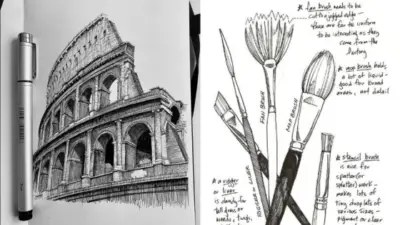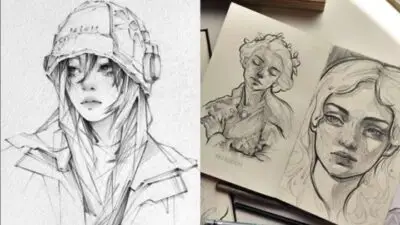Realistic drawing is a captivating art form that allows you to capture the essence of your subjects with precision and detail. Mastering realistic drawing involves understanding the fundamental techniques, essential tools, and the nuances that make your artwork lifelike. Whether you are an aspiring artist or someone looking to improve your skills, embracing these techniques can elevate your drawing to new heights.
To begin, familiarizing yourself with key drawing tools and basic concepts will lay a solid foundation. As you progress, exploring advanced techniques and tips will enhance your ability to create dynamic and true-to-life representations. Consistent practice and dedication to refining your skills will ultimately enable you to achieve impressive results.
Key Takeaways
- Understanding essential tools is crucial for realistic drawing.
- Fundamental techniques form the basis of lifelike representations.
- Regular practice is key to improving your drawing skills.


Understanding Realism in Art
Realism in art is a significant movement that emphasizes the depiction of subjects as they appear in everyday life. It emerged in various forms throughout history, influencing techniques and styles in drawing and painting.
Historical Overview
Realism originated in the mid-19th century as a reaction against the idealized forms of Romanticism. Artists sought to portray ordinary people and everyday scenes with accuracy and detail. Influential figures, such as Gustave Courbet and Édouard Manet, challenged conventions by focusing on realism over exaggeration or romantic ideals.
This movement laid the groundwork for subsequent art styles, including Impressionism. Realism influenced both visual arts and literature, leading to a broader understanding of human experience.
Defining Realism
Realism can be defined as an artistic style characterized by the truthful representation of subjects. It involves meticulous attention to detail, proper proportions, and an emphasis on lighting and shading. The goal is to depict the essence of real life without embellishment.
In drawing realism, understanding the 3D forms and spatial relationships of the subject is crucial. Artists often focus on four key elements: precision drawing, brightness values, edges, and transitions. Value, or shading, plays a vital role in conveying depth and enhancing the three-dimensional quality of your drawings.
Through rigorous study and practice, you can develop your skills in drawing realism, allowing for more lifelike representations in your artwork.


Essential Drawing Tools
Having the right tools is crucial for achieving realistic drawing. The quality of your materials can significantly impact your ability to create detailed and lifelike images. Focus on selecting appropriate drawing pencils and paper types to enhance your artistic process.
Choosing the Right Drawing Pencils
Selecting high-quality drawing pencils is fundamental for realistic textures. Graphite pencils come in a range of grades, from hard (H) to soft (B).
- Hard Pencils (H Grades): Ideal for fine lines and detailed work.
- Soft Pencils (B Grades): Perfect for shading and darker areas.
Consider using a variety of pencils to achieve a broader range of contrasts. Many artists recommend a soft pencil, such as a 6B, for rich shadows while keeping harder pencils, like 2H, for highlights.
Additionally, explore mechanical pencils for precise details and a consistent line. You can also incorporate colored pencils for added depth. Brands like Faber-Castell Polychromos and Prismacolor are popular choices among artists.
Paper Types and Textures
The paper you choose can also influence the final outcome of your drawings. Opt for papers that complement your medium of choice.
- Bristol Paper: Smooth surface, excellent for detailed work and colored pencils.
- Texture Paper: Rough surfaces are better for charcoal and pastels.
Choosing the right texture can add dimension to your work. For a smoother result, select sheets with a cold press finish. For more realistic texture, use hot press or textured papers.
When selecting, consider the weight of the paper as well. Heavier papers (300gsm) support wet mediums, while lighter papers (200-250gsm) work well for dry mediums. Ensure the paper absorbs your chosen materials effectively to enhance realism.


Fundamentals of Drawing for Realism
To achieve realism in your drawings, focus on mastering key principles that include accurate proportions, effective use of light and shadow, and techniques for creating depth. These fundamentals will greatly enhance your ability to render lifelike imagery.
Proportions and Measurements
Accurate proportions are vital in realistic drawing. Start by using reference points to maintain scale and alignment. Utilize basic shapes to block out the figure or object before adding details.
Key Techniques:
- Grid Method: Use a grid to transfer measurements accurately from reference images to your drawing.
- Comparative Measurement: Compare the size of one element to another. For instance, determine how many times the width of an eye fits into the length of a nose.
Frequent practice with observational drawing helps refine your skills in this area.
Light, Shadow, and Value
Understanding light and shadow is crucial for creating volume and texture. Observe how light interacts with objects in your environment. Focus on identifying the light source, which helps establish highlight areas and shadow depth.
Value Scale:
Create a value scale from light to dark to guide your shading techniques.
- Highlight: The brightest spot, usually where the light hits directly.
- Midtones: The transitional shades between light and shadow.
- Shadows: The darker areas formed where light is obstructed.
Gradually blend these values to enhance realism in your work.
Creating the Illusion of Depth
To make your drawings feel three-dimensional, apply techniques that create depth. Perspective is a key element here. Use linear perspective with vanishing points to guide the viewer’s eye into the space of your composition.
Methods for Depth:
- Overlapping: Position objects in front of one another to imply distance.
- Size Variation: Alter the size of objects; closer items appear larger while distant objects are smaller.
- Atmospheric Perspective: Use lighter, duller colors for background elements to simulate distance.
Incorporating these strategies will lead to more convincing and dynamic artworks.


Advanced Techniques and Tips
Achieving realism in drawing requires mastering various advanced techniques. This section delves into methods for creating texture and detail, capturing lifelike portraits, and balancing imagination with observation in your artwork.
Texture and Detailing
Realistic textures enhance the depth of your drawings. Begin by observing surfaces closely—note the differences in light reflection, patterns, and imperfections.
Use Varied Pencil Grades: Use softer pencils (like 6B) for dark areas and harder pencils (like H) for fine details. This variability helps create contrast.
Layering Technique: Start with light strokes and gradually build layers. This adds dimension and depth to textures.
Focus on the Light Source: Determine where the light hits your subject. This knowledge guides shading and helps replicate realistic shadows.
Practice different materials, such as fabric, skin, and metal. Each has distinct qualities that require different approaches for texture depiction.
Capturing Lifelike Portraits
Drawing realistic portraits goes beyond merely outlining features. Attention to proportion and subtle nuances is vital.
Proportions Matter: Familiarize yourself with basic facial proportions. Use the “rule of thirds” to divide the face accurately.
Study Facial Expressions: Observe how muscles and skin react during different expressions. This understanding will translate into more lifelike portrayals.
Capture the Eyes: The eyes are often the focal point. Pay close attention to the iris and reflections to make them more expressive.
Make use of references from real life or quality images. Consistent practice will help you develop a keen eye for detail in facial structure and nuance.
Drawing from Imagination vs. Observation
Both methods serve distinct purposes in drawing. You may find that observation enhances accuracy, while imagination fosters creativity.
Observation: When drawing from life, take your time to study your subject. Analyze proportions and shapes before committing to paper.
Imagination: Engage in sketching sessions that allow free drawing. Prioritize form and perspective, but avoid relying solely on memory without reference.
Try blending both techniques. Start with observational sketches and then modify elements to add your artistic flair. Balancing these approaches will elevate your capability to create realistic art.


Practicing and Improving Your Skills
To enhance your realistic drawing abilities, consistent practice, critical analysis of your work, and continued learning are essential. These practices will help you refine your skills and develop a more effective drawing style.
Regular Practice Routines
Establishing a regular practice routine is vital for improvement. Aim to draw daily, even for a short period. This consistency helps reinforce your skills over time.
Consider the following activities to incorporate into your routine:
- Warm-Up Exercises: Start with basic shapes and lines to loosen up your hand.
- Gesture Drawing: Spend a few minutes capturing the essence of a subject with quick sketches.
- Observation Drawing: Draw objects from life to hone your ability to depict realism accurately.
Use online platforms or drawing tutorials to find structured exercises tailored to your skill level. Engaging in these routines makes practice more focused and productive.
Analyzing and Learning from Mistakes
Reflection on your work is crucial for growth. Identify areas where you struggle, whether it’s proportions, shading, or perspective.
Follow these steps to analyze your drawings:
- Compare with Reference: Place your drawing next to a reference image to assess accuracy.
- Seek Feedback: Share your work with fellow artists or communities to obtain constructive criticism.
- Document Progress: Keep a sketchbook to track improvements and revisit older pieces to see how far you’ve come.
Learning from your mistakes creates a path for targeted improvement. Each error is an opportunity to enhance your skills.
Continued Learning and Education
Stay informed about new techniques and trends in drawing. Participate in workshops, online classes, or watch drawing tutorials that focus on realistic techniques.
Consider these resources:
- Online Courses: Platforms like Udemy or Skillshare offer lessons from experienced artists.
- YouTube Tutorials: Follow channels dedicated to realistic drawing methods for visual and step-by-step guidance.
- Books and Articles: Explore literature on drawing principles that provide valuable insights.
Continued education helps you expand your skill set, introduces you to new materials, and keeps you engaged with your craft. Stay curious and open to learning to elevate your drawing skills further.
- 53shares
- Facebook0
- Pinterest53
- Twitter0



